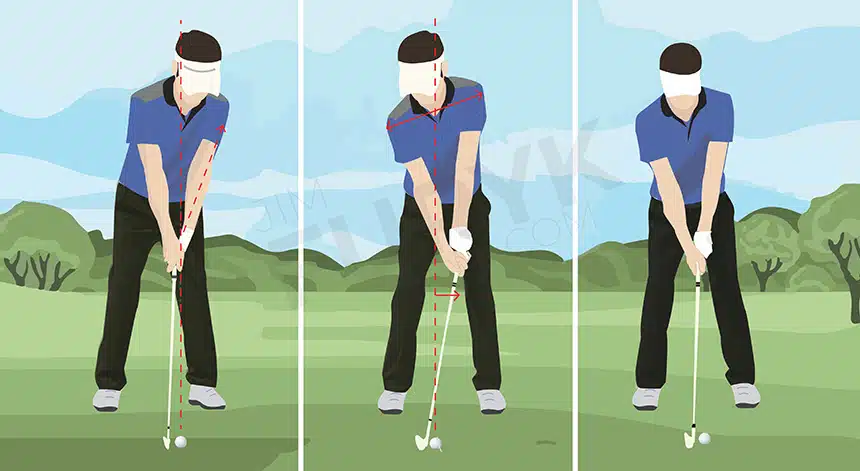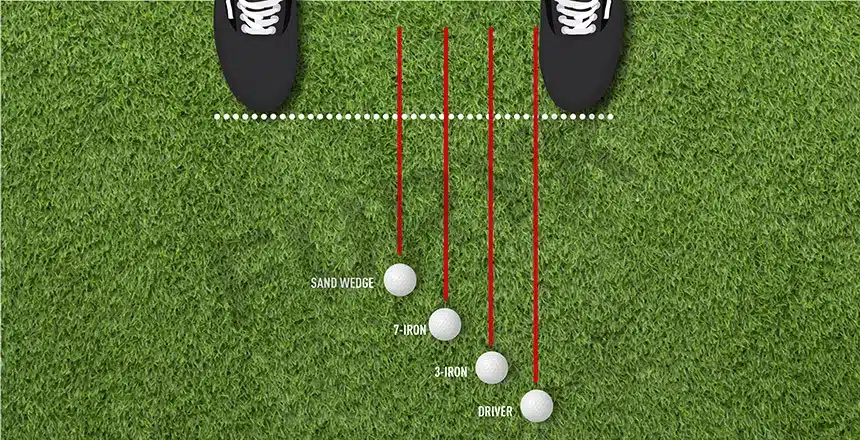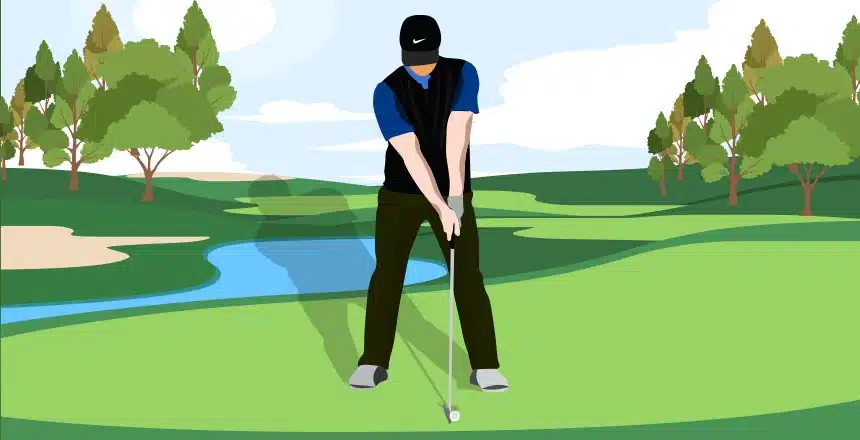It all begins with a proper setup. The key to a solid golf swing and a good golf setup is learning how to correctly position the entire body (feet, arms, hands, etc.) and even the golf ball. There is indeed a one-size-fits-all set of instructions you should be adhering to prior to swinging the club even.
And to be honest, many mistakes made with regards to golf swing actually originate from the parts involved right before the swing itself. So you just have to get your basics right, which includes maintaining a good stance, good posture, good weight distribution, and a proper grip.
In This Post
Your Setup In Golf REALLY Matters!
If you underestimate how important this whole concept of setup is in the game of golf, then maybe you don’t know much about the importance of open/closed skills.
Open skill (in sports in general) consists of those variables you cannot possibly control.
As for closed skill, this can be controlled entirely by you. So no beyond-your-control moving parts or real-time constraints here that tend to affect performance and results.
Sports like golf mainly include closed skills, which simply just translates into ‘you have to be extremely consistent and accurate’. That gives you not enough room to make mistakes, right? Hence, make sure that you’re trying as hard as possible to maximize your consistency and accuracy during your round of golf.
And the very starting point of achieving that is your golf setup. When you can repeat that same setup for your every shot, it allows the swing to acquire consistency. Much in the same manner, if there are variations and inconsistencies in the foundation itself, then your shots will certainly pay the heavy price for it.
So now let’s get to the part where I discuss at length how you can obtain that perfect setup for producing a solid golf swing and, ultimately, a solid strike too!
How to Set Up for A Golf Shot – Step-by-Step Instructions
Your setup controls how powerful and efficient your golf swing is going to be. The address position, in particular, is the most important as it leads to developing good traits to give you a strong, stable footing throughout the round of golf.
Check Your Basics:
- Stance & Foot Positioning
- Ball Positioning
- Weight Distribution (Balance)
- Posture
- Arms and Hands Positioning
- Grip
Now is the time to get to understand the correct golf setup for beginners or if you simply just want to reset your setup and swing mechanics to straighten out or improve your skills.
1. Your Golf Stance & Foot Positioning

This is popularly known as the address position and it consists of your feet placement and that imaginary toe line.
Foot positioning i.e. your stance is the first and foremost step you take toward getting the setup right.
The distance between your feet in the stance should be shoulder-width distance apart for full swings. And it better be too wide if at all, never too narrow because the latter throws you off balance throughout your golf swing. On the other hand, if the stance is wider, the center of gravity is lowered to hand out a greater balance.
Now let me bring to your attention that your golf setup driver stance is slightly wider than that of an iron. Because driver swing, in comparison to iron swing, is a bit different. So with a driver, just a few inches wider in your stance than those full-swing iron shots.
Here’s the video demonstration of a proper golf stance for both driver and irons…
Moving on to that imaginary toe line I was talking about earlier. It starts from the tips of your feet/shoes and travels right down your target line. But not pointing directly at your target, the opposite of which is often thought to be the right approach.
Since the toe line isn’t on top of the ball directly, it extends parallel-left (for a right-handed golfer of course) of the target. Maintain a parallel position between the toe line and your target line because you’re most likely, much like every other golfer, to swing naturally down your feet line. This is what’s implied when referring to golf setup ‘down the line’.
To break it down even further, the path of the clubhead is mostly decided by how your foot is positioned, meaning your stance. This explains very clearly why for the ball flight to be straight, you have to keep the stance straight too. So your stance might change in the case of hitting draws and fades.
Now here’s an additional tip – at address, you can choose to open the front foot just a little bit toward your target if that feels necessary and comfortable. But for this, make sure that both your toes are properly lined up and slightly twist that front foot toward the target for maintaining a toe line that’s “parallel-left”, as we talked about earlier.
With this front foot toe flare, it becomes so much quicker and easier for clearing your hips, thus gaining a little more distance. But then this is optional, something that mostly more experienced/skilled players do when hitting a driver or if they just want to hit their golf club, any club slightly longer.
2. Golf Ball Positioning

I think you already know that how the ball is set up or positioned affects how long it flies when struck. For gaining ‘extra’ yardages, your golf ball should be placed further away from you.
With that strand of reasoning, for your driver, line up the ball with the front foot’s inside part. So you can close that clubface more easily and hit UP.
What about the longest iron then? For that, move your golf ball back, more toward the back foot (keep a distance of half a ball). The general rule is to move ‘down’ with each club (shorter distance). So by the time you reach your wedges, you will have moved the ball around half-a-ball length from that back foot.
For full swings, the golf ball is placed the farthermost, that is right in the center of the stance. Then you have specialty shots like flop shots, which require a different golf ball positioning entirely. This is when the ball is moved toward the front foot a bit, so you can open that clubface for hitting the shot really high.
Another great example is when the ball placement is even farther back. Meaning behind the center of the stance, which works for low-flight punch shots.
Therefore, you get greater spin, as is evident, the farther back the golf ball is set up in the stance. The increase in spin is actually a result of your golf swing being steeper because of the ball being positioned further back in the stance. It’s one of the most effective strategies for putting backspin on your golf ball.
3. Weight Distribution
Your body weight ought to be distributed evenly between your back foot and front foot. So that’s 50-percent of your total weight on your each foot.
When your position or balance is like this, the most natural and relaxed, maintaining steady footing throughout your golf swing becomes possible and more effortless.
Now keep in mind that this also includes your heel-to-toe weight distribution. Meaning where in each foot is your 50-percent weight located. The correct answer is slightly forward in the toes or the balls of the feet. The outcome – increased agility and greater balance throughout your swing!
Golf swings that begin far too back on those heels lose accuracy and power indeed because then you tend to fall backward post-swing. Plus, keeping that clubface square at such times also becomes very difficult, hence solid impact is just not achieved.
4. Golf Posture
So what is that perfect “athletic” golf setup posture? It involves bending at your waist, not the knees (bend knees only slightly), and keeping the spine straight.
Avoid hunching over as that often leads to injuries over time. Also, when you hunch over, you’re making the process of twisting around that curved spine during your backswing a lot more difficult.
Speaking of which, when your golf posture is not right, you end up placing unnecessary stress and pressure on the back, lower back in particular. Doesn’t matter how old you are!
But when done the correct way, it paves the way for an easier swing with much greater force. This way, your muscles and bones move how they were built to move, and are not forced into unnatural or uncomfortable positions.
5. Arms and Hands Positioning
Every golf posture or setup also includes positioning your arms and hands the proper way. Since your waist is bent, you’re supposed to let your arms hang down naturally toward the ground when grabbing your golf club. Do not lower or lift your arms as this brings those arms under too much strain right from the beginning.
So just stay loose and allow the arms to hang straight toward gravity in a very relaxed ‘down’ manner. This is the most ideal golf setup hand position.
And your hands should be a palm-width distance from your body for your short irons and mid irons. So that’s 4 inches to 6 inches. While for your woods and long irons, a palm-length distance, which means the distance from your wrist till the middle finger tip.
6. Grip
As for how to hold your golf club, the step-by-step instructions for golf grip are also very important if you really care about correcting/acing clubface position through impact and generating enough clubhead speed.
The most traditional hold consists of your trail palm pointing in the direction of your target. You should be able to see your glove badge. And those two Vs that are created by your forefingers and thumbs need to face up toward the trail ear.
To be frank, you can tweak the grip a bit based on what feels more comfortable and relaxed to you. Just keep those hands unified and rife with energy on your golf club, but with light pressure so you don’t tense up your forearms.
What Is the ‘Reverse K’ Golf Setup?
This particular golf setup at address approach refers to the almost natural placement of your legs and arms. Here’s its theoretical explanation…
- The two “K” top lines are the arms while those bottom lines are the legs.
- Your back (right one for right-hand orientation) hand is positioned lower on that golf club grip, thus it forms the “K” angled line.
- And the back leg slightly bends due to your shoulders’ tilt, which constitutes the bottom “K’ angled line.
Just remember to not lean far too back on the back foot because then you’ll be overdoing the ‘reverse K’. At address, make sure your posture is relaxed and comfortable.
If the tilt in the shoulder is giving rise to tension in your muscles, know that you’ve gone too far. A too dramatic reverse K position can also present itself in the form of you hitting up on that golf ball a little too much.
How to Improve Golf Setup – 3 Most Effective Drills
Posture Drill
For getting your posture right, just follow the simple instructions below…
- Grab your golf club down by its head using one hand while the other is placed on the club grip. So the golf club is parallel to the floor/ground and at waist height.
- Now keep your spine straight and position that club across the waist while bending over it. This ensures the much-needed waist-bend rather than you bending your knees in your setup posture.
- Then lay the same golf club against your back to check if that remains straight. So the club should be making contact with your spine in 3 different spots at this point – tailbone, between the shoulder blades, and back of the head.
Once you know your spine is straight and the waist bent, your golf posture has reached its faultless version for solidly hitting the ball.
Alignment Pole Drill
Before starting that golf swing of yours, achieving the proper setup is of the utmost importance. And you can actually make that happen simply by using this Alignment Pole Drill.
What you’ll need – alignment sticks or snow poles or even a club you’re not hitting.
- Place one alignment rod, pole, or stick down on the toe line and another parallel to the first but on the farther side of that golf ball.
- Therefore, you don’t really have to think about whether or not your feet are lining up properly.
- During your practice sessions, hitting range balls this way is sure to eventually get you to a place where your feet naturally set up correctly every time.
Balance Drill
Now, how about fixing that weight distribution problem bit…
- Take your setup position to the ball.
- Have someone else push you slightly sideways, forward, and backward.
- Do you, as a result, fall over? If you do in any one direction, it proves that too much of your total body weight is placed on your toes, heels, or either foot.
So the aim is to NOT fall rather stay balanced even if someone gives you a slight push.
Most Common Mistakes In Golf Setup
It’s certainly not the easiest thing to develop a consistent golf swing sequence, let alone achieve that centered, balanced setup position prior to your swing. But you have to keep practicing as much as you can to make no false moves.
Nevertheless, even good players are guilty of developing some of the most unconventional setup positions. Sometimes, such eccentricities work in your favor, as I and Fluff are proof here. But most times, the greater the deviation from basic, usual setup instructions, the higher the struggle with the game of golf.
Now here are the two most common causes that lead to a bad golf setup – i) producing too many angles and ii) poor angles. The latter means pointing your setup in the direction opposite the actual target. For example, tilting down your shoulders instead of keeping them up and away. This is mostly what mid handicappers do and the reason is an incorrect or bad grip.
Because of how strong they are, they tend to push the golf club shaft toward their target and also place the ball behind in the stance.
And as for poor angles, this is a mistake often made by high handicappers. As a result of shoulders tilting in a bad way, you point the body left and pull the head past the ball to compensate.
So it’s more like you have one problem and then because of that, you end up giving rise to so many other problems. Here are those common mistakes you should be avoiding…
- Too Wide Stance
Agreed that a stance that’s slightly wider can make way for greater lateral movement during your golf swing. But it comes at a cost, which is creating a wider and longer swing arc leading to thin and fat shots.
- Too Narrow Stance
When your stance is too narrow (maybe you’re deliberately doing that to counterbalance your excessive lateral movement), your rotation increases and you keep from extreme weight shifting. But then there’s a fine line between that and de-stabilizing your golf swing as an outcome of narrowing the stance a bit extravagantly.
- Bad Angles
High handicappers, more often than not, and bad angles go hand in hand, unfortunately. And that’s mainly because the of too weak “Vs” in their grip that tends to point at the left shoulder. The result of which is the head going past the golf ball and shoulders and hips rotating open to that target line.
So to make amends, they move the golf ball ahead in the stance, which is nothing but a horrible idea.
- Too Many Angles
Having too many angles is surely less threatening to your setup than initiating bad ones (although in the case of the latter, you still have to compensate). But the former is mainly the inevitable consequence of a too strong grip. And this produces the following bad angles…
- Excessive leaning of the shaft toward your target.
- Excessive shoulder tilt.
- Head far too behind the golf ball.
SIMPLY DO THIS TO FIX THESE MISTAKES!
It’s called the neutral golf setup. No matter your handicap or skills, just position the golf ball off your left ear. Keep your feet shoulder-width distance apart (roughly). And then balance your weight evenly on both feet. Head just behind that ball and not a lot of shaft lean (simply a tilt, the slightest, toward your target).
And finally, check your “Vs” in the grip – they are supposed to be pointing between your right ear and shoulder.
All’s Well That Ends Well!
The tiniest adjustments can make the world of a difference when it comes to both golf setup prior to swing and the golf swing itself. And that enormous difference takes the form of your golf ball producing the most optimal trajectory.
Your setup is your pre-shot routine, and this has to be on-point. Period.
And then comes the complete shoulder turn during your backswing and then the full follow-through. But nothing begins, let alone succeeds, without a proper setup that actually places the body as well as your golf club in the right, most beneficial and natural positions for executing a mighty swing.
Replicate that perfect setup each time, and you’ll be hitting consistent shots in no time!

